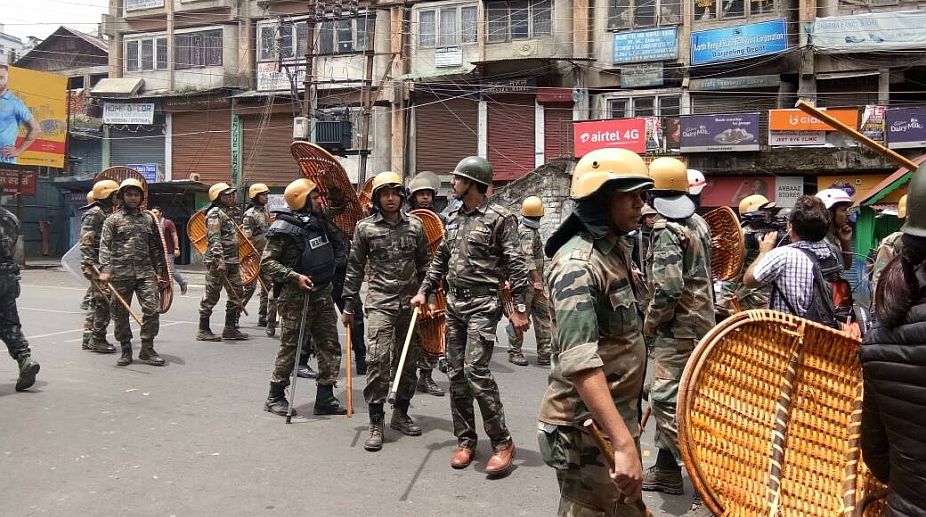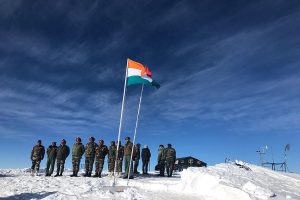The seizure of arms and ammunition from the GJMM office, next to Bimal Gurung’s residence in Darjeeling, has exposed the morcha's violent agenda to buttress its demand for a state of Gorkhaland.
The hills are in ferment on the eve of the scheduled election to the Gorkhaland Territorial Administration. To that can be added the 2009 pre-poll assurance of the BJP to “sympathetically consider” the hill people’s demand if it came to power at the Centre.
Advertisement
This has been iterated by the party’s MP from Darjeeling, SS Ahluwalia. Mamata Banerjee’s frequent trips to the hills and the holding of a cabinet meeting in a surcharged Darjeeling have doubtless brought matters to a head. The NDA-I, led by Atal Behari Vajpayee, had created three states ~ Uttarakhand, Chhattishgarh and Jharkhand ~ as it believed that smaller States are easier to govern.
The likes of Bimal Gurung have been encouraged by this precedent, followed by the creation of Telangana by the Congress in 2013 and the BJP’s sympathy on the issue.
Till 1780, the Darjeeling hills belonged to Sikkim’s Chogyal, but the Nepalese-speaking Gorkhas had fought with him, demanding secession. That year, they captured Darjeeling, Siliguri and other regions of Chogyal’s territory. By 1800, the Gorkhas annexed Sikkim as far east as the Teesta river and the Terai.
The British tried to stem this advance of the Gorkhas to the northern frontier. The Gorkhas were defeated in 1814 and the British made them sign the Sugauli Treaty the next year, compelling them to return to the East India Company the area between the Mechi and Teesta rivers that they had annexed from the Chogyal. In 1817, the Company reinstated the Chogyal, restored the lost tract to him, and guaranteed his sovereignty under the Treaty of Titalia. The conflict with the Gorkhas continued.
In 1835, the Chogyal under a ‘Deed of Grant’, gave the Darjeeling hills, including an enclave of 360 sq. km. to the East India Company.
In November 1864, it signed the Treaty of Sinchula, under which Bhutan ceded the Dooars that it had annexed from the princely state of Cooch Behar along with the passes to the hills of Bhutan and Kalimpong.
By 1866, the present Darjeeling district, spread over 3196 sq. kilometres, assumed its present shape and size. It was made a ‘Scheduled District’ in 1874 and renamed as ‘Backward Tracts’ in 1919. From 1935 to 1947, the region was known as “Partially Excluded Area”. While the demand for a ‘separate administrative unit’ is 110 years’ old, that for a separate State dates back 37 years.
By forming the GTA, the Centre conceded the first demand. In 1907, the Hillmen’s Association of Darjeeling submitted to the Minto-Morley Reforms Committee a demand for a ‘separate administrative set-up’, comprising Darjeeling and Jalpaiguri districts, as people of the hills, particularly the Nepalese-speaking Gorkhas, are generally backward. And linguistically and culturally, they are different from people in the plains.
In 1917, the Association iterated the demand to the Chief Secretary, Government of Bengal, the Secretary of State of India and to the Viceroy and in 1929, to the Simon Commission. In 1930, the Association along with the Gorkha Officers’ Association and the Kurseong Gorkha Library submitted a joint petition to the Secretary of State of India, Samuel Hoare, demanding separation from the Bengal Presidency and in 1941, the Association, led by Rup Narayan Sinha urged the visiting Secretary of State of India, Lord Pethick Lawrence, to carve out Darjeeling from the Bengal Presidency and convert it to a ‘Chief Commissioner’s Province’.
In 1947, the CPI proposed to the Constituent Assembly the formation of Gorkhasthan, comprising Darjeeling district and Sikkim. Ari Bahadur Gurung, a barrister from Kalimpong, also raised the matter in the Constituent Assembly. In independent India, the Akhil Bharatiya Gorkha League (ABGL) was the first political party from the region to demand greater identity for the Gorkha ethnic group and economic freedom for the community.
In 1952, under the presidency of N.B. Gurung, the party met Prime Minister Nehru in Kalimpong and submitted a memorandum demanding Darjeeling’s separation from West Bengal. Over time, the demand for a “separate administrative unit” was stepped up to a separate state, called Gorkhaland. In 1980, in a letter to Prime Minister Indira Gandhi, the Pranta Parishad of Darjeeling, headed by Indra Bahadur Rai, emphasised the need to upgrade Darjeeling to a state.
The Gorkha National Liberation Front (GNLF), led by Subhas Ghisingh, an ex-Serviceman, revived the demand. The expression, ‘Gorkhaland’, was coined between 1986 and 1988 during Jyoti Basu’s regime; Ghisingh’s movement was marked by violence.
A member of his office staff, Bimal Gurung, originally a taxi driver, launched a successor outfit, called Gorkha Jan Mukti Morcha (GJMM) in 2007 and renewed the demand for Gorkhaland. An estimated 1200 people were reportedly killed in Siliguri Terai and Dooars.
Jyoti Basu had assured Ghising that an autonomous entity called the Darjeeling Gorkha Hill Council (DGHC) would be set up. But in 2007, the demand for a separate State was revived once again; Gurung formed a new party, the Gorkha Jan Mukti Morcha.
After agitating for two years, the GJMM accepted the Centre’s offer of an autonomous body, called Gorkhaland Territorial Administration, of which Mr. Gurung became the chief executive. However, for the past few months, he has articulated his dissatisfaction with the functioning of GTA, which explains the renewed demand for Gorkhaland. Ahead of the 2009 Lok Sabha poll, the BJP, then in the Opposition, had promised that it would consider the demand sympathetically.
The GJMM supported the candidature of Jaswant Singh, who won the Darjeeling Lok Sabha seat in 2014. In the July 2009 budget session, three BJP MPs ~ Rajiv Pratap Rudy, Sushma Swaraj and Jaswant Singh ~ strongly pleaded for Gorkhaland.
The demand was defused with the murder of Madan Tamang, the head of the Akhil Bharatiya Gorkha League on 21 May 2010, allegedly by GJMM activists.
The West Bengal government threatened action against GJMM, whose senior leaders were named in the FIR. The talks over an interim arrangement were discontinued on the plea that the GJMM had “lost popular support following the assassination”. On 8 February 2011, three GJMM activists were shot dead by the police as they tried to enter Jalpaiguri district in a padayatra, led by Gurung.
In the 2011 West Bengal Assembly election, the GJMM candidates won three hill assembly seats ~ Darjeeling, Kalimpong and Kurseong ~ implying that the demand for Gorkhaland was still strong. During the 2011 campaign, Mamata Banerjee promised to resolve the Gorkhaland issue.
Elected to power, she and the then Union Home Minister, P Chidambaram, signed a memorandum of agreement with the GJMM on 18 July 2011 for setting up a semi-autonomous body for the Darjeeling hills, namely the Gorkhaland Territorial Administration (GTA).
A bill for the formation of the GTA was passed in the West Bengal Assembly on 2 September, that year. In the elections to the GTA on 29 July 2012, GJMM candidates won 28 seats unopposed. On 30 July 2013, Gurung resigned from the GTA, alleging interference by the West Bengal government and renewed the agitation for Gorkhaland. The economic backwardness of Darjeeling Gorkhas has been chronic. Given the limited scope for jhoom farming, they take up other vocations.
The men drive taxis and other vehicles in the hills, run small shops or act as security guards. The hill people are simple, honest and hard-working to a fault and are trusted by tourists and people from the plains.
The utmost that can be conceded is to make the region a Union Territory, which will cure the 100- year sore.
The writer is a retired officer of the Indian Information Service.











